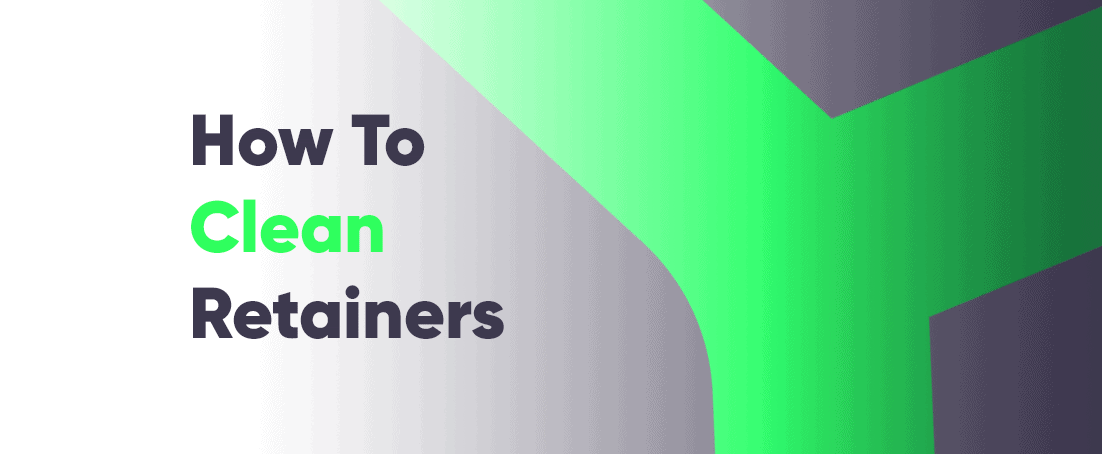
Maintaining that perfect smile after braces requires wearing a dental retainer. But just like teeth, these helpful retainers need regular cleaning to keep things hygienic and prevent problems.
Why do you need to keep retainers clean? A dirty retainer becomes a playground for bacteria, leading to bad breath and potentially encouraging plaque buildup on your teeth. Plus, neglecting cleaning can wear down the retainer, making it less effective or requiring replacement sooner.
Maintaining your straightened smile and your retainer is not difficult. Follow these simple steps for squeaky-clean retainer trays and a healthy oral cavity.
Types of Retainers and Cleaning Considerations
As their materials differ, all types of orthodontic retainers require slightly different cleaning methods. By understanding the type of retainer you have and its material, you can choose the right cleaning methods.
- Hawley Retainers: These classic metal-and-acrylic removable retainers are durable but require a bit more attention. Brush them gently with a soft toothbrush and mild dish soap, avoiding harsh chemicals. Soak them in white vinegar weekly for deeper cleaning.
- Essix Retainers: These clear, plastic retainers are practically invisible and comfortable to wear. Clean the Essix retainers daily with a soft toothbrush (not the one that you use for your teeth) and lukewarm water. Avoid hot water to clean the retainer, as it can warp the plastic. Keeping your clear retainer submerged in distilled water when not in use is a good idea to not let it dry out.
- Bonded Retainers: These permanent retainers, glued to the back of your teeth, are low-maintenance. Simply brush and floss your teeth as usual, paying extra attention to the areas around the bonded retainer wire. Your dentist may recommend additional cleaning with a special tool.
Always follow your orthodontist’s specific cleaning instructions for your retainer. Discuss the appropriate cleaning method for the particular retainer that you have been recommended by the orthodontist. Regular cleaning keeps your smile sparkling and your retainers lasting longer.
Cleaning Guidelines for Hawley Retainers
Hawley retainers, with their combination of metal and acrylic, need daily cleaning to stay squeaky clean. Here’s how to clean your hawley retainers properly:
- If your Hawley retainer has removable metal clasps, gently unhook them before starting.
- Give your retainer a quick rinse under lukewarm running water to remove any loose food particles. Then, soak it for 10-15 minutes in a solution of lukewarm water and mild dish soap (avoid harsh chemicals or toothpaste!).
- With a soft-bristled toothbrush, gently clean the retainer inside and out. Be extra careful while cleaning around the acrylic, as harsh scrubbing can scratch it.
- Rinse thoroughly with warm water to remove any soap residue.
- Lay your retainer on a clean, absorbent towel to air dry.
For a deeper clean once a week, soak your Hawley retainer in distilled white vinegar and water cleaning solution. Just remember to rinse it thoroughly afterward!
Cleaning Guidelines for Essix Retainers
Essix orthodontic retainer needs a touch of daily TLC to stay clean. Here’s how to keep it clear and warp-free:
- Every morning, give your Essix retainers a quick rinse under cool running water.
- Once or twice a day, brush your plastic retainers with a very soft toothbrush and lukewarm water. You can add a mild, non-abrasive cleanser, but skip the harsh stuff like toothpaste, which can scratch the plastic.
- After rinsing or brushing, lay your Essix retainers on a clean, dry towel to air dry. Avoid direct sunlight or harsh heat, as this can warp the plastic.
- Avoid hot water, dishwashers, and steaming, as heat warps the Essix retainer.
To clean stubborn stains, soak your Essix clear retainer in a 50/50 mix of white vinegar and water for 20 minutes, then rinse thoroughly.
Cleaning Guidelines for Bonded Retainers
Bonded or fixed retainers, glued directly to your teeth, are low-maintenance, but they too need a thorough cleaning. Here’s how to make sure your permanent retainer stays plaque-free:
- Twice a day, brush your teeth thoroughly with a soft-bristled toothbrush and fluoride toothpaste. Pay extra attention to the areas around the bonded retainer wire.
- Avoid using harsh chemicals or abrasive toothpaste on your bonded retainer, as they can damage the adhesive or scratch the metal wire.
- Regular flossing is crucial for bonded retainers, as food particles and plaque can easily get trapped under the wire.
- Consider using interdental brushes to clean tight spaces around the retainer wire and between teeth to remove stubborn plaque buildup.
For a deeper clean of your retainer, visit your dentist regularly for professional cleaning. They can remove any stubborn plaque or tartar buildup that you might miss at home.
Daily Cleaning Routine
Maintaining a daily cleaning routine for your retainer is crucial to ensure a clean oral environment and ward off bacteria and plaque.
Food and drinks can stain your retainer, impacting its appearance. Daily cleaning prevents discoloration and unpleasant odors, ensuring confidence in social situations. Additionally, daily cleaning ensures comfort by preventing buildup around the retainer that could irritate your gums, guaranteeing a snug, irritation-free fit.
A proper fit and proper maintenance of your retainers play a crucial role in maintaining orthodontic treatment results. You can learn how should a retainer fit to increase the effectiveness of your treatment.
It is important to adhere to specific daily cleaning instructions tailored to your retainer type, as explained above.
#1 How to Clean in the Morning
Beginning your day with a clean retainer is essential for oral hygiene. It’s convenient as you’re near the sink while removing removable retainers during your teeth brushing routine. These quick and easy steps keep your retainer in top-notch condition.
- Remove: Gently take off your retainer. Use care to avoid any abrupt movements that could damage it or harm your teeth.
- Rinse: Give your retainer a thorough rinse under lukewarm water. This helps remove any saliva or leftover residue.
- Brush: Use a soft toothbrush and mild dish soap to gently clean your retainer.
- Insert: Once cleaned, reinsert your retainer carefully.
#2 How to Clean in the Evening
A nightly routine for cleaning your retainers is key to maintaining their effectiveness and ensuring a hygienic oral environment. Follow these simple steps in the evening to keep your retainers in optimal condition.
- Remove: Gently remove your retainer.
- Rinse: Rinse it under lukewarm water.
- Brush: Use a soft toothbrush and mild dish soap to delicately brush your retainer. This removes any leftover debris, maintaining a clean and fresh surface of the retainers.
- Soak: Occasionally soak your retainer in a vinegar and water solution, or a persulfate free retainer cleaner. This step ensures a more thorough cleansing, eliminating any stubborn buildup. Rinse the retainers well.
- Insert: After cleaning, carefully reinsert your retainer. Confirm its snug fit to support your teeth effectively throughout the night.
Deep Cleaning Methods
#3 How to Clean Retainer With Vinegar Soak
Deep cleaning sessions should be a regular part of your removable retainer maintenance. Using a vinegar soak can be a game-changer in maintaining your retainer’s hygiene. Follow these simple steps to keep your retainer clean.
- Prepare Solution: Mix equal parts white vinegar and lukewarm water in a container to prepare an effective and eco-friendly retainer cleaning solution.
- Soak: Place your retainer in the prepared vinegar cleaning solution. Let it soak for 15-20 minutes.
- Rinse: After soaking, give your retainer a good rinse under running water to remove any residual vinegar taste and ensure it’s ready for use.
- Brush: Remove any loosened debris with a soft toothbrush.
- Soak in Water: To neutralize the vinegar smell and ensure no residue remains, give your retainer a final soak in plain distilled water for a few minutes.
#4 How to Clean Retainer With Baking Soda Paste
Following these steps, harness the natural cleansing power of baking soda to give your retainer a thorough clean:
- Create Paste: Mix a small amount of baking soda with water to form a paste. This natural abrasive paste is gentle yet effective in removing stains and bacteria from your retainer.
- Apply Paste: Using a soft toothbrush, apply the baking soda paste to your retainer. Ensure even coverage.
- Brush: Gently brush your retainer with the baking soda paste.
- Rinse: Thoroughly rinse your retainer under running water to remove the baking soda residue.
- Soak in Water: Conclude the process by soaking your retainer in plain water for a few minutes. This final step guarantees a clean and neutral retainer, ready for your use.
#5 How to Clean Retainer With Hydrogen Peroxide Soak
Enhance your retainer-cleaning routine with the sanitizing power of hydrogen peroxide. Follow these simple steps to ensure safe, risk-free retainer cleaning method with it:
- Dilute Peroxide: Start by diluting 3% hydrogen peroxide with an equal part of water. This creates a safe yet effective solution for disinfecting your retainer.
- Soak: Place your retainer in the diluted hydrogen peroxide solution. Allow it to soak for 15-20 minutes.
- Rinse: After soaking, thoroughly rinse your retainer under running water to remove any residual peroxide taste and ensure it’s safe for use.
- Brush: Gently brush your retainer with a soft toothbrush to remove any loosened particles.
- Soak in Water: Conclude the cleaning process by soaking your retainer in plain water for a few minutes.
Storing and Transporting Retainers
To ensure the cleanliness and longevity of your retainers, storing them properly is important. Investing in a sturdy, well-ventilated retainer case protects your retainer from dust and accidental damage. After cleaning, allow your retainer to air dry completely before storing it, avoiding moisture buildup that can lead to bacterial growth.
When it comes to transportation, never wrap your retainer in a tissue, as it can trap moisture and bacteria. Keep it in its case to prevent contamination. Avoid leaving the retainer loose in pockets or bags to protect it from dirt and potential damage. It is highly recommended to keep a retainer case in your bag or pocket wherever you go.
#6 Ventilated Containers
- Choose the Right Container: Select a container with proper ventilation features, such as small holes to keep the retainer inside fresh.
- Avoid Moisture: Prevent moisture buildup by choosing well-ventilated containers. Proper airflow helps to minimize condensation, preserving the quality of retainers.
- Clean Container: Regularly clean your ventilated containers to remove dust or debris that might obstruct airflow.
- Avoid Direct Sunlight: Place ventilated containers away from direct sunlight. This prevents heat buildup and potential damage to the retainers.
Professional Cleaning and Maintenance
#7 Orthodontic Check-Ups
Orthodontic check-ups are crucial for maintaining the effectiveness of your treatment and ensuring lasting results. Follow these recommendations to make the most of your orthodontic appointments and keep your smile in optimal condition with a clean retainer.
- Regular Visits: Schedule and attend regular check-ups with your orthodontist. These visits allow professionals to monitor your progress, make necessary adjustments, and address any emerging issues promptly.
- Professional Cleaning: Opt for professional cleaning during your orthodontic appointments as it ensures plaque and debris are effectively removed from hard-to-reach areas of the retainer.
- Adjustments: Be open to necessary adjustments during your check-ups.
Your orthodontist will guide you on when can you stop wearing a retainer. Follow their recommendations for a successful transition out of orthodontic treatment.
#8 Ultrasonic Cleaners
While traditional cleaning methods work well, ultrasonic cleaner offers a convenient and effective alternative to clean retainers, especially for those seeking professional-grade results. Let’s explore some top recommendations for an ultrasonic cleaner based on your needs:
- Professional Use: Orthodontists use high-powered ultrasonic cleaner to ensure thorough and hygienic retainer cleaning.
- Effectiveness: These handy devices use high-frequency sound waves to gently remove plaque, bacteria, and stains, leaving your retainers fresh and hygienic.
- Recommendation: When selecting ultrasonic cleaner models, prioritize those with large capacity to accommodate multiple dental appliances, multiple cleaning cycles for diverse materials, and durable construction to withstand frequent professional use.
Final Thoughts
Adopting a meticulous approach to retainer care is pivotal for both oral health and the longevity of these devices. From daily routines like rinsing, brushing, and soaking to periodic deep cleaning with solutions like vinegar, baking soda, or hydrogen peroxide, consistency is key to keep your retainer clean.
By integrating these practices into your daily routine and attending regular orthodontic check-ups, you not only maintain a healthy smile but also ensure your retainer remains an effective ally in preserving your orthodontic achievements.



